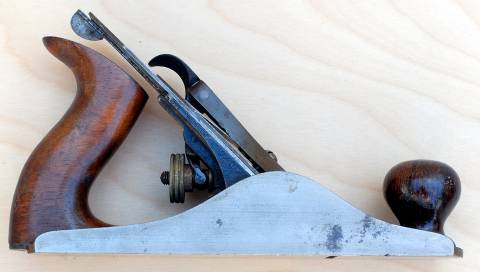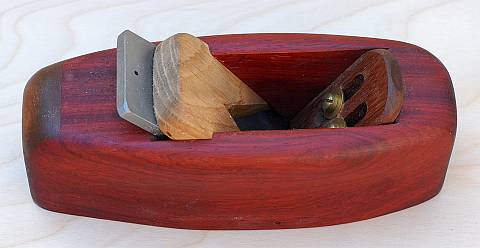
This #4 Bailey plane is a refugee from sometime before WWII. I'm not sure exactly when it was made, but it is one of a large number of cast-iron planes which were common before the age of power tools. Of course, since it is cordless it is still usable. Cast iron planes like this had a few advantages over the wooden bodied planes they displaced.:
- Levers and screws for adjusting the plane blade. The lever which is visible at the top of the plane skews the blade from side to side to make sure it is going to cut an even depth across the width of the blade. The brass adjusting knob sets the distance that the blade extends from the sole. This controls the depth of the cut.
- Cast-iron bodies don't warp with changes in humidity (they rust)
- Cast iron soles wear longer and therefore the mouth of the plane - essential for taking a fine cut - stays consistant over time.
- They are easily mass-produced and the final adjustment can be made by the user.
This was probably one of the first planes I owned. I'm sure I picked it up at a garage sale or flea market, brought it home, sharpened it up and used it for things like planing door bottoms or putting a chamfer on posts. It is great for rough work. While it works well, it is not perfect. And in fact, getting better meant taking a step backwards.

This is what I mean by going backwards. No more iron. No more screw/lever adjustments. Just a block of wood, a wedge, and a couple of set screws. This is a plane made by Steve Knight sometime early this century. Steve is one of a handful of retro-plane makers who take the designs of the past and re-interpret them in new materials or in differing ways. In this case, some of the woods are not traditional. The sole is made of Ipe - a hard tropical wood and the thing is laminated together using modern glues. The dark-brown l piece of wood is held in by a couple of screws and is used to control the width of the mouth of the plane as it wears. But really the biggest change between this and the other plane is the thickness of the blade.
As you can see from the two photos below, the Stanley blade is thin. It is about an eighth of an inch thick and thus is somewhat flexible. The chip-breaker (the curved piece above the blade) adds some minimal support to it, but it does not compare to the very thick blade on the Steve Knight smoother.


With this thicker blade, and a mouth that can be closed down to a very fine width, the Steve Knight plane can take much finer cuts than the Stanley ever did for me. It has a couple of other advantages as well:
- Wooden body is warm and easy on the hands.
- The shape allows shifting your grip depending on the direction you are planing
- Slides well over the workpiece and is incapable of leaving a rust mark
- Retro / Handmade feel
- Thicker blade is easier to get a nice flat edge on.
- Can flatten the sole quickly by running it over some sandpaper
There are some disadvantages to it. Adjustment is done by tapping the blade with a mallet. It can take a while to get the hang of that. Potentialy the wood could warp and twist, but so far it seems very stable in the moderate climate I live in.
So for fine work the victor of the battle is actually the simpler of the two. Of course for rougher work I still pull out the cast iron plane. Nothing wrong with having more than one tool for the job.
Some plane links:
- For history and Identification of Stanley planes nothing beats Patrick Leach's "Blood and Gore" site
- For more about Steve Knight's planes go to the source: Knight Toolworks
- HNT Gordon offers some lovely wood and brass shoulder planes at their store.
- St. James Bay offers a number of planes based on old designs.
There are a number of other boutique plane makers out there like those of Thomas Lie-Nielsen who updates classical designs or the new Veritas line of planes from Lee Valley which seek to add new features while updating traditional designs.

Comments (1)
Reminds me of the PBS show "The Woodwright's Shop" with Roy Underhill. Hokey and cheesy, but it's also fascinating to me. Mandatory Saturday afternoon viewing.
Try to catch the episode he did on planes - their history, how they're made, how they work. Awesome stuff. :-)
Posted by Josh Bancroft | May 24, 2006 1:11 AM
Posted on May 24, 2006 01:11